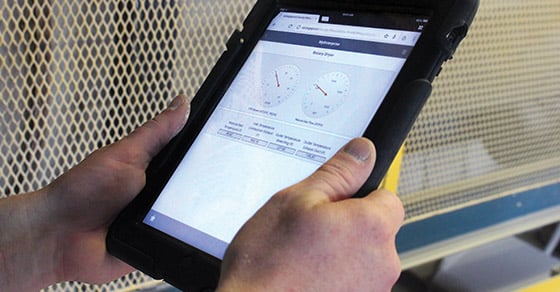When it comes to processing bulk solids, the debate over which type of industrial dryer – rotary or fluid bed – is superior continues to plague the industry. Adding to confusion is the fact that there are many myths clouding the decision-making process when choosing between the two types of dryers, particularly in relation to energy efficiency.
Here, we’ll take a deeper look at the misconceptions surrounding rotary dryers and fluid bed dryers to reveal the truth about energy efficiency for each type.
Misconception: Fluid bed dryers use less fuel than rotary dryers
A long-held belief in the industrial drying sector has been that fluid bed dryers boast a reduced fuel consumption compared to rotary dryers.
This myth stems from the fact that fluid bed dryers promote increased air-to-material contact (i.e., improved heat transfer) compared to rotary dryers, making them more thermally efficient. For this reason, manufacturers will often claim that fluid bed dryers are far more efficient in terms of fuel consumption – by as much as 40%.
Reality: Fluid bed dryers and rotary dryers are comparable in terms of fuel consumption
While it is true that fluid bed dryers offer enhanced heat transfer and therefore improved thermal efficiency compared to rotary dryers, some of this efficiency is lost due to the lower inlet gas temperatures fluid bed dryers use (typically around 900℉ vs. the 2100℉ commonly used in rotary dryers).
So while it’s true that rotary dryers are less thermal efficient in theory, the higher temperatures they employ allow for increased efficiency, making up for some of this loss in efficiency. In reality, therefore, fuel consumption between rotary dryers and fluid bed dryers is comparable.
Misconception: Further energy savings are achieved through recirculated cooling air
Another common misunderstanding relates to the fluid bed’s use of recirculated air from the exhaust gas system. While it is true that fluid bed dryers can offer further energy savings through the use of recirculated air, the benefits are not immediately obtainable.
Reality: The use of recycled exhaust reduces efficiency, but can be addressed
Fluid bed dryer manufacturers may claim that recycled exhaust air from the cooling portion of the unit can be recirculated to the inlet gas in order to give the appearance of additional energy savings.
The idea behind this myth works well on paper, but requires a little extra work in practice.This is because the recirculation of exhaust air from the cooling section of a fluid bed dryer allows entrained particles to be recirculated to the inlet system as well. This can plug duct work and blind the perforated plate, reducing efficiency, as less air volume is able to perforate through the plate. Furthermore, recycled exhaust gas contains more moisture, requiring higher product temperatures and ultimately, higher exhaust temperatures.
As a result, simply implementing recycled exhaust air from the cooling section can actually decrease overall efficiency unless further action is taken.
To remedy the issue of blinding and plugged duct work, an intermediate form of dust collection, such as a baghouse or cyclone, must be implemented on the recycle stream.
When these measures are put in place, energy savings can be significant.
Misconception: Fluid Bed Dryers are, Overall, More Energy Efficient
For the reasons described above, it is a common belief that fluid bed dryers are just generally more energy efficient than rotary dryers.
Reality: They Require Much More Electricity
Because fluid bed dryers require an additional amount of air in order to fluidize the material, a high amount of electricity is necessary. This can add to energy costs by as much as 20%.
Furthermore, because of this need for a set air volume, variations in the particle size of the feed material will decrease the efficiency of the fluid bed dryer, forcing the customer to only dry particles in a certain size range for maximum efficiency.
This also increases costs because the exhaust gas handling equipment (ductwork, fan, cyclone, scrubber, etc.) must be much larger in order to accommodate the greater air volume.
However, the thermal efficiency gained can make up for this added cost.
Misconception: Evaporative cooling improves efficiency
An additional myth regarding energy savings is that of the evaporative cooling effect. Fluid bed dryer manufacturers will often claim an energy savings of up to 10% as a result of evaporative cooling.
Reality: True, but to a much lesser extent
The effects of evaporative cooling are real; chilled or cooled air will evaporate a portion of the moisture when exposed to a warm, moist material. However, this figure is often severely exaggerated, again to give the appearance of a greater savings in energy. While some manufacturers may claim up to 10% energy savings from evaporative cooling, this figure is, on average, closer to 2%.
Guaranteed Results
While a better understanding of these principles will help in making a more educated decision during the dryer selection process, it can still be difficult to know what is fact and what is fiction. An easy way to work around this issue is to ask the manufacturer for a guarantee on the efficiency of the system.
An efficiency guarantee will ensure that the manufacturer will work to meet the estimated energy requirements of the system.
Similarly, asking for customer references can also be helpful in learning how a dryer actually performs, versus how it performs in theory.
Conclusion
FEECO has been serving the bulk solids drying industry since 1951. We’ve tested and designed systems for hundreds of materials, giving us an unmatched expertise in industrial drying. We manufacture custom rotary dryers and fluid bed dryers around the parameters of a given material to ensure the most efficient drying solution for the application at hand. For more information on our industrial drying systems, contact us today!



